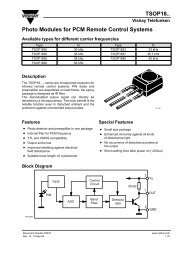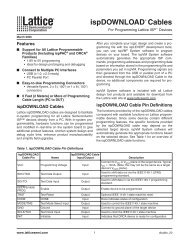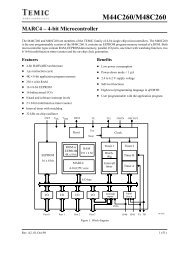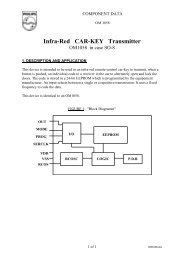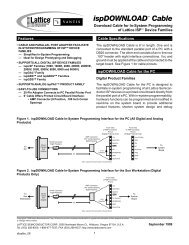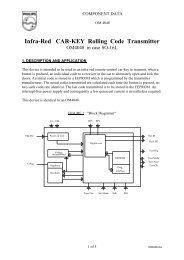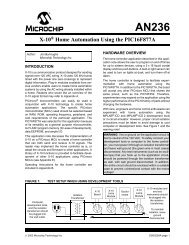You also want an ePaper? Increase the reach of your titles
YUMPU automatically turns print PDFs into web optimized ePapers that Google loves.
<strong>PICREF</strong>-4SOFTWARE OVERVIEWThe software is written in ’C’ using MPLABC, V1.21.There is only a main function and one function calledButtoncheck.Main FunctionInitializationThe main function begins by initializing all of the RAMregisters used, and setting the TRIS register so thatthe zero crossing sense, dim button, and bright buttonpins are set as inputs, and so that the TRIAC drive pinis set to be an input. The OPTION register is set toassign the prescaler to the timer with a ratio of 1:64,timer to increment on internal clock, and enable theweak pull-up resistors on GP0, GP1, and GP3.The next statement sets the output latch of GP2 (theoutput to the TRIAC) high. Note that this statementonly sets the output latch high. Since it is set to be aninput at this point, the pin will be at high-impedance.Because the internal RC oscillator of the PIC12C508can vary with temperature and supply voltage (the Vddsupply should be fairly constant at 5V), the programconstantly keeps track of the total Timer0 count ofeach half cycle of the AC line. If this were not doneand the count was too long for maximum dimming, theTRIAC would be fired shortly after the next half-cyclehad begun and actually cause the lamp to be on fullbright instead of full dim. The rest of the code beforeentering the main program loop synchronizes theTimer0 count with the line voltage so that the linefrequency/Timer0 count is known.Main Program LoopThe main program loop counts the line cycles andcalls Buttoncheck after DelayCnt cycles. If it is nottime to call Buttoncheck, two short routines are run,one for the positive and one for the negative half-cycleof the AC line. The routines are identical except for theline polarity checking, so only one will be described.The line phase is checked to see if the next half-cyclehas already begun. If it has, Maxdim is incrementedand a wait state is initiated to re-synch with the linevoltage. If it hasn’t, the program waits for the linevoltage to cross zero and when it does, resets Maxdimto match the half-cycle time. If the selectedon-percentage is selected to be greater than full dim, itis reset to give full dim.The timer is set to time out when the TRIAC should befired for the desired brightness. The program thengoes into a loop to wait for either the timer to roll overto zero, or for the AC line half cycle to expire.The TRIAC is then fired by setting the pin connected toit’s gate to be an output (the output latch was alreadyset high) to supply current into the gate. A short delayis initiated to widen the firing pulse before againsetting the pin to a high-impedance. The TRIAC willshut off when the AC line voltage next crosses zero.Buttoncheck SubroutineThis subroutine checks for presses of the BRT andDIM buttons and increments or decrementsPercenton based on their states.If both buttons are pressed and the lamp is not off, it isturned off. If it is already off, it is turned on full bright.In addition to taking commands from the buttons, atest function is built in to this routine. The test mode isentered by holding both buttons, and then releasingand pressing DIM again. The test will run for 255cycles or until the DIM button is pressed. The testruns in a cycle of brightening to full bright, dimming tofull dim and then flashing full bright twice.After the section of Buttoncheck where the testcycling is done if the program is in test mode, theprogram checks the buttons for the sequence to entertest mode, and looks for a both pressed for instant onor off. Following this code is the single button up anddown commands with checking for more than fullbright and less than full dim.DESIGN MODIFICATIONSThis reference design will work for many applicationswithout modification. It is anticipated that customersmay want to customize its functionality, however, andthis section offers suggestions for modification:• The software was written for a 60Hz line frequencyand might work on a 50HZ line, but hasnot been tested at anything but 60Hz.• Modify the circuit to use a single button. For thismodification, pressing the button would turn thelamp on and off, and if held, would graduallybrighten the lamp to full bright, then gradually dimto full dim. The brightness would stay at whateverlevel it was at when the button was released.• Add a light level sensor such that if full darknesswas sensed when the button was pressed, thelamp would gradually brighten to avoid shockingeyes adjusted for darkness.• Add a sensor to automatically switch the lamp onand off based on the room occupancy.• Use the two available pins to add a serial bus forcontrol from remote computer.• Add a "Halloween" mode that would flash thelamp at random times for a short period to simulatespooky lightning and such.• Add a photo sensor to maintain a given brightnesslevel in a room depending on ambient light.© 1997 Microchip Technology Inc. DS40171A-page 5




